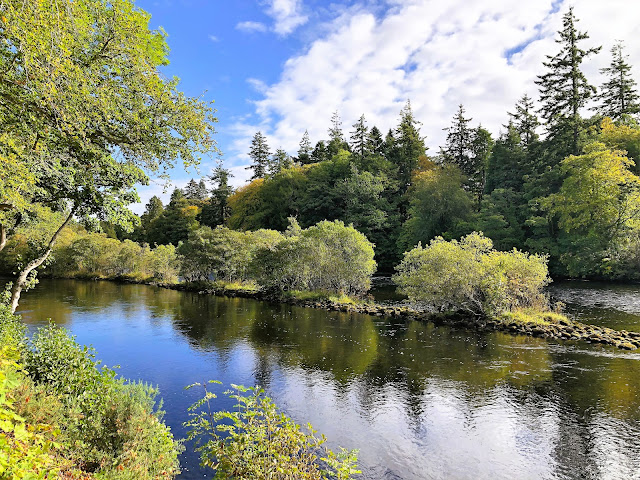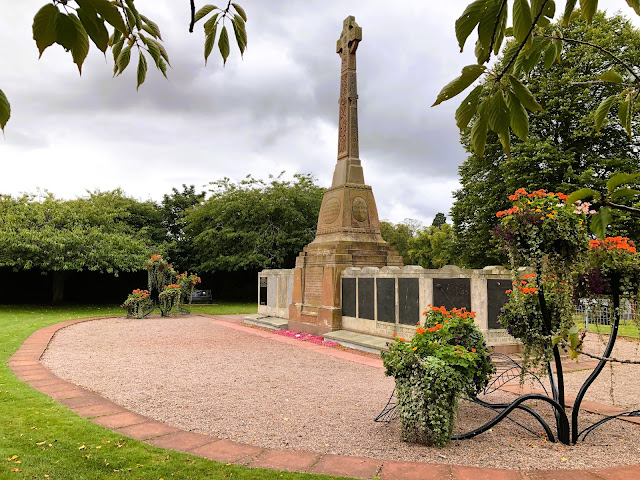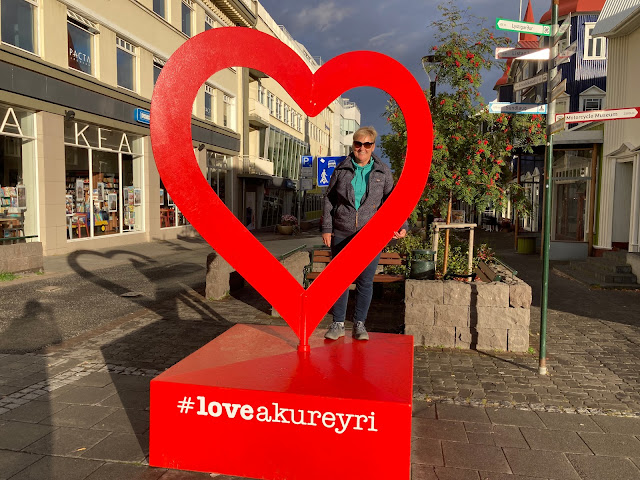EUROPE – PART 4.
As the Island Princess eased out of Reykjavik harbour, the cool, damp end-of-September day reminded us of a late-November day in Halifax. After four hectic days spent seeing as much of Iceland as time and energy would allow, we enjoyed two days at sea as the ship sailed south of the Faroe Islands and between the Shetlands and the Orkneys, before slipping into her berth at Invergordon on Cromarty Firth.
For the first time since our cruise began, we had to collect tickets onboard from Customs agents before setting foot on dry land. Since Great Britain left the European Union, things have become more complicated for people entering the country. Although it turned out to be just a formality, the process to get off the ship delayed us by a couple of hours and shortened the time we had to visit Invergordon and nearby Inverness.
We followed the crowd to a bus stop and were the last to board the local bus, paying about $35 for two return tickets. There being not much to see in tiny Invergordon, Inverness was the place to go. It’s a nice city, about the same size as Charlottetown, with a lovely downtown and a lot of history. Rather than visit the historic buildings as most people did, we opted for a stroll along the beautiful Ness River, upstream for four kilometers or so, then crossed and returned on the other bank. The Ness runs through the center of the city, emptying Loch Ness into Moray Firth.
A few men fly-fished for salmon. The technique and gear they use here is quite different from what I’m used to: two-handed roll casting with a very long rod. I could have watched them all day. We paid our respects at the World War I cenotaph, one of the most beautiful we’ve seen in our travels. Then we strolled along the main shopping street, stopped for a coffee, tea, and a scone, and I watched the world go past on a pleasant Saturday while Elva did a bit of shopping at Marks & Spencer. We took Bus #25 back to Invergordon and boarded the ship, very satisfied with our day. As we cruised out of Cromarty Firth, I took a shot of one of several offshore drilling rigs moored there. The landscape in the background could have been Pownal as seen from Orwell Bay.
Our last stop on this cruise was Newcastle, England’s most northerly city, home to about 300,000 people. The ship docked near the town of Tynemouth. From there, we took the train into the city center; two return tickets cost us the grand sum of $16. The place to go on a Sunday in Newcastle is the Quayside market which runs along the River Tyne. On our way down, we visited Saint Nicholas Cathedral and admired the intricate alabaster carvings. The ones shown in the photo adorn the magnificent pulpit.
The highlight of the river walk is the Gateshead Millennium Bridge, a unique design that ‘tilts’ rather than swings, to allow boat traffic to pass. It is the world’s first tilting bridge and is functional as well as beautiful. Also shown in the photo is the stunning Sage Gateshead, a concert venue and music education centre.
Thirty-one days may sound like a long time to be on a cruise ship but it’s never long enough for us. Despite being cooped up in our tiny cabin for six days, we very much enjoyed our trip. It took us to places we’ve always wanted to visit, the weather was good for the most part, and we learned a great deal about the countries we visited, bringing us to ninety-four in total.
It was our first voyage with Princess; we’ve only ever cruised with Holland America. The main reasons we chose this cruise were timing and itinerary. It may be a function of the cruise business post-COVID, but we’ve noticed changes in the service level since our first cruise nine years ago, none of them for the better. Comparing Princess to Holland America, we can’t think of a single thing that’s better on Princess. In fact, most of the amenities and services are slightly below what we’ve experienced with Holland America. Perhaps the best example of this is the food in the cafeteria, some of which really wasn’t fit to eat. Bottom line, prices have gone up and service levels have suffered. This doesn’t mean we won’t cruise again or that we won’t cruise with Princess, but the reality is that things may never be as they were.
We left the ship quite early on September 27 and took an Uber to Southampton Airport. Our Uber driver is a member of a large Afghan community who arrived in the UK in the early 2000s. He told us his life story, about how he was accepted as a refugee, and how life is here with his wife and four children.
We are still able to travel independently, carrying one backpack and a couple of carry-ons each. I love the mental and physical challenge of not taking the easy way when it comes to transfers and the like. We watched hundreds of people leave the ship and stand in line at the cruise terminal, looking confused and waiting for a bus to take them God knows where. I ordered my Uber on my iPhone; my app told me exactly when the driver would arrive, what kind of car he was driving, and his license plate number; there is no cash involved as payment is by pre-authorized credit card. What could be easier?
At the airport in Edinburgh, we found the express bus that took us to within a ten-minute walk of our accommodations, a bachelor apartment in the Haymarket district. Our first day began with a walk toward the center of the city, breakfast at a café, and a stroll up to the magnificent Edinburgh Castle. We spent three hours there, listening to our audio guide and taking in the scale of the place. There are too many layers of history for me to get my head around. Put simply, the stronghold has been a fortress for at least 1,000 years and it absolutely dominates the Edinburgh skyline. We were moved by the stories of individual bravery recounted in regimental museums and the National War Memorial (second photo) and impressed by the royal jewels and the royal palace. And the views of the city from the ramparts are breathtaking.
The walk down the Royal Mile toward Holyrood Castle, the King’s residence in Scotland, took us past St. Giles Cathedral (interior shown in the first photo) and the Parliament of Scotland. On a hunch, we took the visitors’ entrance and learned that anyone can just walk in and watch the Members of the Scottish Parliament debate from the visitors’ gallery. So, we did. What a novel idea! Scotland has had its own Parliament since 1999 with similar powers to a Canadian province, has had one unsuccessful referendum on independence from the United Kingdom and, if the present government has its way, will have another public vote soon.We enjoyed glorious, sunny weather during our second day in Edinburgh. Our modest apartment has one great advantage: it’s within easy walking distance of all the important sites. Our itinerary for the day included a visit to the National Museum of Scotland, a twenty-five-minute walk through Old Town, one of two UNESCO World Heritage Sites in the city. The Museum is very well laid out and has some very interesting collections. It’s not all old stuff, and the place is airy and bright. We spent a few hours there and then walked to Princes Street in the main shopping area so that Elva could engage in her favourite pastime while I took the afternoon off. I'm happy to report that she made it back to our apartment without getting lost! And even happier to report that she didn't spend any money other than to buy me a replacement umbrella.
The second photo below shows Dolly, the first mammal to be cloned successfully from a single cell
in 1996, and the third shows a four-man track racing bike dating from about 1900, the only
one of its kind known to exist in the UK.
After dinner, we strolled around New Town, the second of Edinburgh’s UNESCO sites and enjoyed the vibrant restaurant and pub scene of an early fall evening.
On our last day in Edinburgh, we visited the Scottish National Gallery. While we’re not art afficionados, we enjoyed our time there very much. After taking one last stroll along the Royal Mile, we walked back to our lodgings in driving rain and a 90 km/hr headwind, reminding ourselves that: “There’s no such thing as bad weather, just the wrong clothes!”
Elva and I have been fortunate enough to visit many of the world's great cities, outside North America, and spend a few days there: Paris, London, Rome, Singapore, Sydney, Barcelona, Vienna, Prague, and Budapest. Edinburgh ranks near the top in our experience. The people are friendly, there is lots to do, the city is beautiful, clean, safe, and interesting, and things here are reasonably priced.
Tomorrow, we’ll pick up our rental car and spend nineteen days driving around the countryside with plans to visit the Inner and Outer Hebrides and the Orkney Islands along the way. Land-area wise, Scotland is about the same size as New Brunswick and Prince Edward Island combined, but all the islands we want to visit make planning a trip much more challenging. I’m not looking forward to driving on the ‘wrong’ side of the road, but I’ll do my best. Wish me luck!

























































